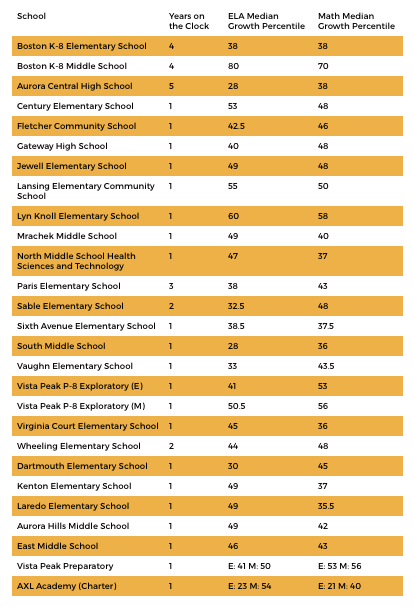As the end of the accountability clock draws near for Aurora Public Schools, the district has to create systems that support school-level improvements in its lowest performing schools. Though the district has begun to take steps to improve its lowest performing schools–creating the International Leadership Innovation Zone and replacing Fletcher Community School with a high-performing charter–APS should strive to ensure that they have a clear plan and are including stakeholders in the turnaround process. Community buy-in is vital to successful turnaround, a lesson painfully learned in Denver and many districts nationwide.
Aurora has seen some success in its turnaround schools. As of the last school performance framework ratings, there are 18 Aurora schools on the accountability clock. Boston K-8’s middle school, which had been on the accountability clock for 4 years, demonstrated outstanding PARCC growth this past year with students growing faster than 80% of similar students in Math and Language Arts. According to the preliminary ratings for the 2015-2016 school year, Boston and five other school are no longer on the accountability clock. Unfortunately, seven more Aurora schools are now on the accountability clock.
On the other hand, Aurora Central High School, entering its fifth year on the clock, saw only 6.6% of 9th grades meet or exceed expectations on the ELA PARCC exam, down 2.1 percentage points from 2015. Aurora Central High School is still on the accountability clock and faces State Board of Education action this year. Below, is a table listing all APS schools currently on the accountability clock as well as the amount of time they have been on the clock and the median growth percentiles based on 2016 PARCC results.
Boston K-8 and Aurora Central High School joined three other Aurora schools in the International Leadership Innovation Zone, approved by the State Board of Education last year. In the creation of the innovation zone, APS partnered with Mass Insight, a group known for their district turnaround expertise. The Innovation Zone includes Aurora Central, Aurora West, Crawford Elementary, Boston K-8, and Paris Elementary. A+ Colorado provided reviews finding that the plans, while adequate for innovation status, were not all adequate turnaround plans. Aurora Central’s innovation plan in particular does not represent best practices or lessons learned in school turnaround.
School turnaround is a difficult process that requires engagement at all levels–from the highest levels of district leadership to the specific classrooms, students, and families in turnaround schools across the district. Turning around low-performing schools is critical to change the narrative and outcomes for many of Aurora’s students.
School turnaround often leads to confusion, frustration, and a sense of alienation among community and school district employees. Even though districts want to improve underperforming schools, they frequently become the enemy of students, families, and teachers in the neighborhood. These stakeholders feel like the district is not listening to them during the turnaround process; they feel like their perspective is irrelevant to the district as it makes decisions for them. For example, the community at Montbello High School in Denver continues to struggle through these challenges five years after DPS began the school turnaround. A+ has compiled recommendations based on the Denver experience with school turnaround that could be one of many resources for APS as they continue to work on improving the lowest performing schools. APS needs to examine the failures and success of this and other turnaround efforts to make the most of the opportunity to improve student achievement at Aurora Central High School, and make it a model for successful school turnaround.
APS needs to communicate with stakeholders in the neighborhood and, with their help, develop a clear plan for turnaround. APS should not reinvent the wheel on turnaround— and in fact it should look for guidance from turnaround experts that include but are not limited to Mass Insight Education, who is already working with the district on its Innovation Zone strategy. In addition to this guidance throughout the process, the plan needs to be deeply contextualized and involve the community. With leadership from the community and experts in turnaround, APS could use the turnaround of Aurora Central High School to develop a framework for improving schools across the district.
Recommendation Updates:
- Engage the community in turnaround planning and progress monitoring to ensure that turnaround plans reflect the needs of the families, students, and communities they serve.
- Create a public turnaround monitoring system that includes consistent reports to the school board/community on indicators of turnaround progress.
- Provide opportunities for community and district leaders to visit turnaround schools and provide their input into the turnaround process and progress.
Find the rest of the blogs here:
Strategic Plan
Community Engagement
Family-Friendly Rating System
Exemplar New Schools
Serving High-Need Students
Early Childhood Education
Increase Funding

